Papers by Tetsuya Nakajima

Japan Journal of Physical Education, Health and Sport Sciences, 2021
The present study aimed to clarify the establishment of Judo etiquette during the wartime and pos... more The present study aimed to clarify the establishment of Judo etiquette during the wartime and postwar periods. Nakamura (2011) discussed Japanese martial arts etiquette in modern Japan. In his work, however, he dealt largely with Kendo etiquette, and inadequately addressed the history of Judo, as well as overlooking the period of Allied occupation (1945-1952). This article focuses on the reformation of Judo etiquette in that period and clarifies its historical background. It was revealed that, first, the enactment of etiquette in August 1940 was intended to be a criticism of Taro Inaba, who was excommunicated at the Kodokan. Inaba had criticized the Kodokan and the Dai Nippon Butokukwai, stating that when a judoka stands and bows with shizen hontai (natural posture) it reflects disrespect to the emperor. During the war, with the increasing influence of State Shinto, Inaba's claim could have undermined Judo's social credibility. Therefore, the Kodokan and Butokukwai abolished shizen hontai and in its place instituted the posture of attention, the basic Shinto posture, and this was also followed by the military and adopted in middle school games; thus, the current system of courtesy was established during this period. Furthermore, the practice of sitting on tatami mats with the left knee and standing up with the right foot was adopted in 1943 to match the postures stipulated in State Shinto. The etiquette established during the war was modified during the Occupation, when bowing to feudal seniors and the kamidana were abolished. In addition, the choice of bowing posture, whether at attention or a natural posture, was left to the practitioners. In this way, it can be said that Judo etiquette was democratized. However, college students' conduct during Judo bouts was disturbed after the Tokyo Olympics in 1964. Consequently, wartime etiquette was revived. However, the Kodokan did not disclose that its etiquette was influenced by State Shinto and the military. The official line was that the etiquette was based on principles of Judo such as seiryoku-zenyo (maximum use of energy) and jita kyoei (mutual welfare and benefit).
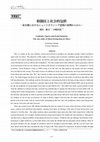
Japan Journal of Sport Anthropology
This is a study on the way children viewed and treated as outsiders are included socially within ... more This is a study on the way children viewed and treated as outsiders are included socially within combative sports dojo in Tokyo. The objective of this study is to analyze and reveal how combative sport dojo embrace "ostracized" kids such as delinquent juvenile, the bullied, and truant students, empower them and help them return to social institutions such as schools and workplaces. Previous studies show that combative sports gyms play roles of social inclusion; however, few studies are done on the process of returning to the society. The viewpoint of "social inclusion," (from Ikemoto's study in 2009) seems to be the only one that analyzes the people who have already been included in the society. This study focuses on children in need of social inclusion: how dojo motivation transforms them into someone who "fits" into schools or other social settings such as workplace or as professional athletes. The initial trigger for them was the desire to become strong, however this study reveals how that affects their full transformation. The methods used for this study are: instructing the kids in the dojo, doing extensive fieldwork as a resident counselor at schools in a specific region inside Tokyo from 2002 until March 2009; and as an advisor for the development of young people from then on until March 2017. The author has spent a great amount of time with the children in schools and dojo, and this has enabled him to capture the full picture of each child's life, including their family backgrounds. A number of interviews were conducted not just with the children but also with the teachers and parents in order to prevent inevitable personal biases that arise from merely spending time with the children in one-on-one environment. In order to build a rapport with the kids, the author attended and participated in the local events such as 'mochi-tsuki' (pounding boiled rice into soft, gelatinous cakes), harvesting bamboo shoots, fireworks and other festivals. There are a total of over 200 children attending the dojo in a span of 12 years, there has been a wide variety of races, cultures, and individual personalities, ranging from hyper to lethargic with each of them having their own reasons to visit the dojo. The author analyzes these personality types and notes their traits respectively within the research document. For example, children that have hyper personalities are usually the ones labeled as "delinquent" and they have a high possibility of becoming involved in violence. Children who are lethargic and labeled as disinterested or under achievers, on the other hand, were often the bullied and are generally truant students. Most of
Research Journal of Budo, 2014
The Historical Sociology of Japanese Martial Arts contains a comprehensive history of Japanese ma... more The Historical Sociology of Japanese Martial Arts contains a comprehensive history of Japanese martial arts compiled by Spanish historical sociologist Raul Sanchez Garcia. However, it is not simply an overview intended to introduce Japanese martial arts to the West. In this work, the field of Japanese martial arts is used as a case study. According to Raul, his motivation for writing the book was in that although Norbert Elias was particularly fascinated by the Japanese civilizing process, he finished his research career without turning his hand to it. Furthermore, Raul himself has developed his own career as a researcher in the path laid down by Elias’ sociology, and this work displays Raul’s zeal to tackle the challenges left by Elias.

Taiikugaku kenkyu (Japan Journal of Physical Education, Health and Sport Sciences)
The purpose of this study was to clarify the establishment process of the Kosen Judo Taikai (Nat... more The purpose of this study was to clarify the establishment process of the Kosen Judo Taikai (National High School and Vocational School Judo Competition; referred to hereafter as KJT), which was hosted by Kyoto Imperial University (KIU) from 1914. Only few attempts have been made to study the establishment of this competition. Yumoto (1977) has stated that the KJT adopted two diŠerent sets of rules for refereeing (Kodokan rules and Butokukai rules), but he did not discuss how these rules were adopted. The present study speciˆcally clariˆes the development of the refereeing rules at the KJT, in the context of increasing emphasis on competition. The studyˆndings were as follows: 1) The original aims of inter-scholastic matches were self-discipline and promoting friendship between schools. Competition was not the main focus. 2) The Fourth Higher School (referred to hereafter as Shikoh) considered``goodwill'' to be the aim of their match with the Third Higher School (referred to hereafter as Sankoh) in April 1907. However Shikoh, as representatives of the Hokuriku district, actually became more concerned with victory. Shikoh devised tactics to achieve draws in individual matches in order to win the competition. 3) This competitive spirit caused disputes between Sankoh and Shikoh after April 1907. In discussions to arrange subsequent matches, each school tried to propose conditions favorable to itself, which led to repeated breakdowns in discussion. 4) It also became the custom to hold discussions over the refereeing rules before interscholastic competitions between Sankoh and the Fifth and Sixth Higher Schools. In these discussions, the issues that needed to be resolved were the length of the matches, the means of determining victory and defeat, rules governing submission holds, the order of referees, and the number of members in a team competition. 5) The idea for the KJT had already been proposed by KIU in February 1912, but it took 2 years and 10 months to be realized. It took that long for the higher schools to develop fair rules for interscholastic competition. 6) The rules developed for the KJT were diŠerent from both Kodokan and Butokukai rules. In conclusion, the KJT was established through a process in which each participating school, while pursuing rivalry with the other schools, was able to compromise to come up with a set of rules that would be fair to all.
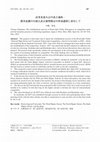
Taiikugaku kenkyu (Japan Journal of Physical Education, Health and Sport Sciences), 2013
The purpose of this study was to clarify the establishment process of the Kosen Judo Taikai (Nat... more The purpose of this study was to clarify the establishment process of the Kosen Judo Taikai (National High School and Vocational School Judo Competition; referred to hereafter as KJT), which was hosted by Kyoto Imperial University (KIU) from 1914. Only few attempts have been made to study the establishment of this competition. Yumoto (1977) has stated that the KJT adopted two diŠerent sets of rules for refereeing (Kodokan rules and Butokukai rules), but he did not discuss how these rules were adopted. The present study speciˆcally clariˆes the development of the refereeing rules at the KJT, in the context of increasing emphasis on competition. The studyˆndings were as follows: 1) The original aims of inter-scholastic matches were self-discipline and promoting friendship between schools. Competition was not the main focus. 2) The Fourth Higher School (referred to hereafter as Shikoh) considered``goodwill'' to be the aim of their match with the Third Higher School (referred to hereafter as Sankoh) in April 1907. However Shikoh, as representatives of the Hokuriku district, actually became more concerned with victory. Shikoh devised tactics to achieve draws in individual matches in order to win the competition. 3) This competitive spirit caused disputes between Sankoh and Shikoh after April 1907. In discussions to arrange subsequent matches, each school tried to propose conditions favorable to itself, which led to repeated breakdowns in discussion. 4) It also became the custom to hold discussions over the refereeing rules before interscholastic competitions between Sankoh and the Fifth and Sixth Higher Schools. In these discussions, the issues that needed to be resolved were the length of the matches, the means of determining victory and defeat, rules governing submission holds, the order of referees, and the number of members in a team competition. 5) The idea for the KJT had already been proposed by KIU in February 1912, but it took 2 years and 10 months to be realized. It took that long for the higher schools to develop fair rules for interscholastic competition. 6) The rules developed for the KJT were diŠerent from both Kodokan and Butokukai rules. In conclusion, the KJT was established through a process in which each participating school, while pursuing rivalry with the other schools, was able to compromise to come up with a set of rules that would be fair to all.
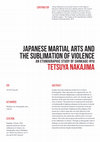
Martial Arts Studies
Shinkage-ryu, ethnography, kata, violence 10.18573/mas.68 In Japan, the study of Japanese martial... more Shinkage-ryu, ethnography, kata, violence 10.18573/mas.68 In Japan, the study of Japanese martial arts is rooted in historiography. Other approaches are comparatively rare. Yet, it would be extremely enlightening to undertake fieldwork on the classical Japanese martial arts, and to ask a broader range of questions. In this spirit, this study is interested in exploring the issue of violence. The martial arts are understood by researchers to fundamentally be fighting techniques, but the aspects of martial arts that have attracted the attention of researchers in the past have been the psychology of fighting and the pedagogy of the martial arts. I wish to argue that one of the objectives of the classical Japanese martial arts was to learn, through the practice of the martial arts, the wisdom that could be used to overcome violence. This study, then, proposes that martial arts are motivated by the 'sublimation of violence'. Through an ethnographic study of shinkage-ryu, this study explores how the sublimation of violence is practiced in the dojo and elucidates the structure and practice of classical kata that have largely remained hidden.
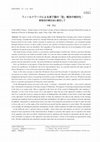
Taiikugaku kenkyu (Japan Journal of Physical Education, Health and Sport Sciences)
We report a study of the dojos (training halls) of the Shinkage-Ryu (teaching style) school of Ja... more We report a study of the dojos (training halls) of the Shinkage-Ryu (teaching style) school of Japanese sword fencing, a foundational martial art, through fieldwork and an examination of the kata concept of Minamoto Ryouen based on the results. Earlier research on martial arts, not limited to Minamoto, was conducted mainly through literature reviews. In those studies, however, the realities of martial art practices that are not clearly evident in the literature were not identified. The originality of the present study lies in its investigation of the actual conditions of martial art practices on the basis of fieldwork. This study focuses on kata, which is a core practice method unique to martial arts. However, previous literature searches on kata have not achieved notable results. It is rare for shosa (conduct and movements) associated with kata to be described in detail in the martial arts literature, although descriptions of the spiritual nature and physical sense have been described from the standpoint of oriental thought patterns. This is because kata is based on practice and not described in words. The present fieldwork examined the manner in which kata is practiced. How can fieldwork reveal aspects of kata that have been unaddressed in literature studies? Unless this issue is solved, the significance of fieldwork will not be demonstrated. Here, we critically relativize the kata concept of Ryoen Minamoto, in view of the lack of previous efforts to do this. Study of the kata concept revealed that Minamoto discovered the principle of repeating the same physical movement as its basis. Furthermore, Minamoto considered that the character and individuality of the creator disappeared during the course of acquiring universality as part of traditional culture. However, Minamoto asserted that kata tends to be a form of practice in which formalized procedures are merely repeated, and that therefore there is a risk that such practice will become a mere formality. In the Shinkage-Ryu dojos surveyed in this study, 2 concepts-omotetachi and toho-were used to represent kata. Omotetachi corresponds to the kata concept of Minamoto. The purpose of teaching and practicing omotetachi in the dojo is to acquire toho. Toho is regarded as the basic use of the sword in Shinkage-Ryu and comprises 3 elements: (1) the vector of the sword, (2) to step ahead to where the tip of the opponent's bamboo sword falls, and (3) to swing the sword in a single movement. In Shinkage-Ryu, the bamboo sword used is of the same length as the opponent's sword and building the ability to strike the opponent's fist takes up the majority of the training, reducing any handicap based on physical build and establishing a fair fight at a given distance from the opponent. In addition, omotetachi is constructed in such a way that, if one keeps the movements of (2) and (3), then one need to focus only on (1), or the angle of the sword between oneself and the opponent, to resist defeat. The omotetachi is an example for learning the geometric mechanisms of toho, which comprises the skills that compose omotetachi. In the fieldwork sites, a practice known as kudaki, a form where kata and matches are mixed, was employed instead of mere repetitions of the omotetachi shosa. Kudaki is a practice that requires one to respond to the attack of an opponent who does not follow formalized steps by applying toho learned in omotetachi and the ideas of toho. In kudaki, in response to the opponent's uncertain movement, a variety of movements are generated by using toho. The kata method has the potential to produce shosa that are not present in omotetachi.
Taiikugaku kenkyu (Japan Journal of Physical Education, Health and Sport Sciences)

Asia Pacific Journal of Sport and Social Science, 2012
Although the founding of judo by Kanō Jigorō has been well studied, perhaps less is known about t... more Although the founding of judo by Kanō Jigorō has been well studied, perhaps less is known about the sociohistorical background behind its formation. This paper considers how the system of judo was constructed in the context of the formation of the nation state in Japan. Each aspect of Kanō's judo was developed in response to specific conditions – in particular, the Ministry of Education's aversion to the martial arts. Kanō developed what he referred to as the ‘values’ of judo in the context of the ministry's adoption of gymnastic exercises for the physical education curriculum. Moreover, Kanō believed that continuity with older schools of jujutsu was important, although in order to legitimize judo's patriotic credentials, he rejected the prevailing theory of jujutsu's Chinese origins. At the same time, he also excluded ‘frivolous’ techniques and attempted to restore jujutsu to its ‘original’ noble essence as a practical form of combat. The diverse and flexible history of jujutsu came to be forgotten.
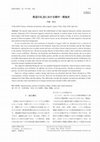
Taiikugaku kenkyu (Japan Journal of Physical Education, Health and Sport Sciences)
The present study aimed to clarify the establishment of Judo etiquette during the wartime and pos... more The present study aimed to clarify the establishment of Judo etiquette during the wartime and postwar periods. Nakamura (2011) discussed Japanese martial arts etiquette in modern Japan. In his work, however, he dealt largely with Kendo etiquette, and inadequately addressed the history of Judo, as well as overlooking the period of Allied occupation (1945-1952). This article focuses on the reformation of Judo etiquette in that period and clarifies its historical background. It was revealed that, first, the enactment of etiquette in August 1940 was intended to be a criticism of Taro Inaba, who was excommunicated at the Kodokan. Inaba had criticized the Kodokan and the Dai Nippon Butokukwai, stating that when a judoka stands and bows with shizen hontai (natural posture) it reflects disrespect to the emperor. During the war, with the increasing influence of State Shinto, Inaba's claim could have undermined Judo's social credibility. Therefore, the Kodokan and Butokukwai abolished shizen hontai and in its place instituted the posture of attention, the basic Shinto posture, and this was also followed by the military and adopted in middle school games; thus, the current system of courtesy was established during this period. Furthermore, the practice of sitting on tatami mats with the left knee and standing up with the right foot was adopted in 1943 to match the postures stipulated in State Shinto. The etiquette established during the war was modified during the Occupation, when bowing to feudal seniors and the kamidana were abolished. In addition, the choice of bowing posture, whether at attention or a natural posture, was left to the practitioners. In this way, it can be said that Judo etiquette was democratized. However, college students' conduct during Judo bouts was disturbed after the Tokyo Olympics in 1964. Consequently, wartime etiquette was revived. However, the Kodokan did not disclose that its etiquette was influenced by State Shinto and the military. The official line was that the etiquette was based on principles of Judo such as seiryoku-zenyo (maximum use of energy) and jita kyoei (mutual welfare and benefit).
SSRN Electronic Journal, 2000
Within the framework of a perfect loan market, this paper clarifies the conditions crucial to whe... more Within the framework of a perfect loan market, this paper clarifies the conditions crucial to whether individual incomes converge or diverge.
International Electron Devices Meeting. IEDM Technical Digest, 1997
We developed the 1T/1C FRAM device technology using 0.5 μm design rule which is perfectly compati... more We developed the 1T/1C FRAM device technology using 0.5 μm design rule which is perfectly compatible with 0.5 μm CMOS logic process. This technology achieves the small 1T/1C FRAM cell size of 12.5 μm2, and minimized process degradations of ferroelectric material characteristics using low-power inter layer dielectric film deposition technique. Using this technology, we successfully integrated the 68 kbit-FRAM and
We developed FRAM (FRAM is a registered trademark of Ramtron International Corporation that stand... more We developed FRAM (FRAM is a registered trademark of Ramtron International Corporation that stands for FeRAM) technologies that are fully compatible with half-micron CMOS logic's. The technologies achieve 1T/1C FRAM cell 12.5 micrometer2 in a size and 68k-FRAM embedded 8bit-MCU. The CMOS transistors work at 5V for a cell operation and 3V for a logic operation. We did not use
Physical Review E, 2009
An one-step replica-symmetry-breaking solution for finite connectivity spin-glass models with K b... more An one-step replica-symmetry-breaking solution for finite connectivity spin-glass models with K body interaction is constructed at finite temperature using the replica method and thermodynamic constraints. In the absence of external fields, this construction provides a general extension of replica symmetric solution at finite replica number to one-step replica-symmetry-breaking solution. It is found that this result is formally equivalent to that of the one-step replica-symmetry-breaking cavity method. To confirm the validity of the obtained solution, Monte Carlo simulations are performed for K = 2 and 3. The thermodynamic quantities of the Monte Carlo results extrapolated to a large-size limit are consistent with those estimated by our solution for K = 2 at all simulated temperatures and for K = 3 except near the transition temperature.
Journal of the Physical Society of Japan, 2008
Journal of the Physical Society of Japan, 2008
ABSTRACT

Uploads
Papers by Tetsuya Nakajima